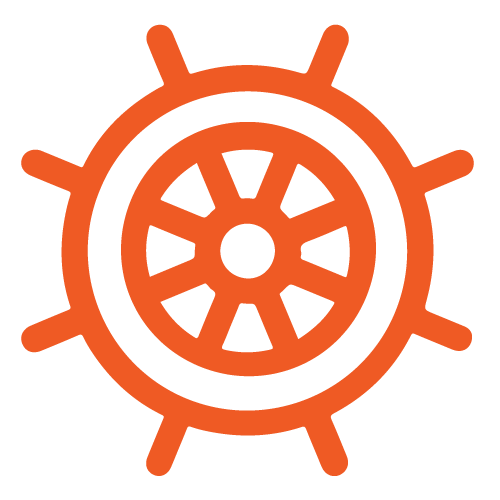Navigational lights are essential for maritime safety, serving as critical guides in the vast and often treacherous marine environment. These boat navigation lights provide visibility, communicate vessel position and direction, and are key to preventing collisions at sea. They are more than just functional equipment; they are the visual language of water travel, vital for safe navigation, especially during night or in poor visibility conditions.
This article focuses on two main aspects of marine navigational lights: the requirements and intelligent practices. While adhering to required standards ensures basic safety and compliance, intelligent practices involve optimizing the use of these lights through maintenance, technological upgrades, and efficient use. Both aspects are crucial for safe and efficient maritime navigation, making understanding navigational lights indispensable for anyone venturing into the waters.
Decoding the Fundamentals of Navigation Lights
Navigation lights, an integral part of maritime operations, are specialized lighting fixtures installed on vessels. Their primary purpose is to provide visibility to other boats and to indicate a ship's size, type, and direction of travel, particularly during times of reduced visibility, such as night or foggy conditions. These lights follow specific color codes and positioning, enabling seafarers to determine other vessels' relative angle and movement, which is crucial in preventing collisions.
The critical role of navigation lights in ensuring maritime safety cannot be overstated. By adhering to international standards and regulations, these lights serve as a universal language at sea, allowing captains and crew from different nations and backgrounds to navigate safely in shared waters. Proper use of navigation lights is a fundamental aspect of maritime safety, as they provide essential information that helps mariners make informed decisions about their course and speed to avoid accidents and navigate safely through busy or hazardous waters.
Essential Requirements for Navigation Lights
The requirements for navigation lights are standardized to ensure uniformity and safety across various types of vessels. Here's an overview of these requirements, highlighting how they vary based on vessel size and type:
Color and Positioning Standards:
- Red Lights: Positioned on the port (left) side of the vessel.
- Green Lights: Placed on the starboard (right) side.
- White Lights: Includes stern lights (at the rear) and, depending on the vessel, masthead lights.
Visibility Range:
- Different classes of vessels have specified visibility ranges for their lights, typically ranging from 2 to 6 nautical miles, with larger vessels requiring longer visibility ranges.
Specific Light Types for Different Vessels:
- Power-driven Vessels: Require masthead lights, sidelights, and a stern light.
- Sailing Vessels: These vessels use sidelights and a stern light under sail. When under power, they must also display a masthead light.
-
Vessels at Anchor: Generally required to display an all-around white light visible from all directions.
Special Lights for Specific Situations:
- Towing Lights: Yellow lights are used when towing to indicate the nature of work.
- Fishing Vessels: Have specific light configurations to indicate they are engaged in fishing.
Intensity and Arc of Visibility:
- Each light type has a required intensity and an arc of visibility, ensuring they are seen from specific angles relative to the vessel.
Variations by Vessel Size:
- Small vessels, like personal watercraft and small fishing boats, have less stringent requirements, often with combined lights for practicality.
- Larger commercial vessels have more complex lighting systems to indicate their size, direction, and activity.
Adherence to these requirements is crucial for maintaining safety at sea. The variations based on vessel size and type ensure that the lighting system is tailored to each vessel's visibility needs and operational characteristics, thereby facilitating clear communication and safe navigation in all maritime conditions.
Exploring the Various Types of Navigation Lights
The world of maritime navigation relies heavily on various types of navigation lights, each serving a specific purpose. Understanding these lights is essential for safe and effective sea travel.
Bow Lights: Illuminating the Forward Path
- Purpose: Bow lights are positioned at the front of the vessel. They help in indicating the vessel's heading and width.
- Colors: Typically, they feature red on the port side and green on the starboard side.
Stern Lights: Indicating Presence from the Rear
- Location and Color: Positioned at the stern (back) of the vessel, these lights are always white.
- Function: They inform other vessels of the presence and orientation of the ship from behind.
Masthead Lights: Signaling Vertically
- Placement: Located on the mast of a vessel.
- Visibility: These white lights are visible from the front and sides, indicating the vessel's length and the direction it's facing.
All-Round Lights: Ensuring 360-Degree visibility
- Design: These lights offer 360-degree visibility, making them visible from all directions.
- Usage: All-round lights ensure a vessel is visible from any angle, providing visibility in all directions.
Towing Light: Signaling Towed Vessels
- Color and Purpose: Yellow in color, these lights indicate that a vessel is towing another.
- Placement: Positioned above the stern light to differentiate from other types of vessels.
Port and Starboard Sidelights: Side Awareness
- Colors: Red for port (left) and green for starboard (right).
- Role: These lights are crucial for determining the direction in which a vessel is moving, especially in crossing or meeting situations.
Tricolor Light: The Combined Solution
- Feature: Combines red, green, and white lights in a single fixture.
- Specific Use: Primarily used by sailboats, allowing other vessels to ascertain their course and angle, especially at a distance.
Each type of navigation light plays a unique role in maritime safety, helping vessels to communicate their position, orientation, and type to others sharing the waterways. Understanding and correctly using these lights is fundamental to safe and responsible seamanship.
Operational Requirements for Navigation Lights
The operational use of navigation lights is governed by specific requirements, ensuring they serve their purpose effectively in various conditions. Understanding these requirements is crucial for maintaining safety at sea.
Time-Based Regulations: From Dusk Till Dawn
-
Period of Operation: Navigation lights must be operational from sunset to sunrise. This period is critical as visibility decreases, necessitating the use of lights for identification and location purposes.
-
Automatic Activation: Many modern vessels have sensors that automatically activate these lights at dusk and deactivate them at dawn, ensuring compliance without manual intervention.
- Twilight and Dawn: When natural light conditions change rapidly and can affect visibility during twilight and dawn hours, you should exercise extra caution.
Adapting to Weather and Visibility Challenges
-
Reduced Visibility Conditions: Besides nighttime, you must use navigation lights in any situation of reduced visibility, including fog, heavy rain, snow, and even sandstorms in certain regions.
-
Enhanced Visibility: In such conditions, the lights are critical indicators of a vessel's presence, direction, and type, aiding navigation and preventing collisions.
- Regulatory Compliance: Adhering to these operational requirements is a matter of safety and regulatory compliance. Violations can result in penalties and pose serious risks to maritime safety.
Implementing Smart Practices in Navigation Lighting
Adopting smart practices to maintain and manage navigation lights is essential for optimal performance and longevity. These practices enhance safety and contribute to the overall efficiency of maritime operations.
Consistent Maintenance for Optimal Performance
Regular maintenance is vital to the effective functioning of navigation lights:
-
Routine Checks: Conducting regular inspections to ensure all lights function correctly and are visible.
-
Cleaning Lenses: Regularly cleaning light lenses to maintain maximum visibility and output.
- Electrical System Checks: Verifying the integrity of the electrical connections and wiring to prevent failures.
Consistent maintenance ensures that navigation lights are always ready for use, especially in critical situations where visibility is paramount.
Strategies for Replacing Damaged Lights
-
Immediate Action: Promptly replace damaged or non-functioning lights to maintain compliance and safety.
-
Spare Parts Onboard: Keeping spare bulbs and parts onboard enables quick replacements and reduces downtime.
Timely replacement of damaged lights is crucial in maintaining the vessel's visibility and adhering to navigational safety standards.
Considerations for Upgrading Lights
When considering upgrades to navigation lights, it's essential to account for several factors:
- Technological Advancements: Evaluate the latest lighting technologies for better performance and reliability.
- Regulatory Compliance: Ensure upgrades comply with the relevant maritime navigation lighting standards.
-
Cost vs. Benefit: Consider the long-term benefits, such as energy efficiency and durability, against the initial cost of upgrading.
Upgrading to more advanced lighting systems can offer improved visibility, energy efficiency, and reduced maintenance needs.
Comparing LED and Traditional Bulbs for Efficiency and Durability
The choice between LED and traditional bulbs is significant in terms of efficiency and durability:
-
Energy Efficiency: LED bulbs are known for their lower energy consumption compared to conventional bulbs.
-
Longevity: LEDs typically have a longer lifespan, reducing the frequency of replacements.
- Brightness and Visibility: LEDs offer brighter, more consistent light, which is crucial for navigation safety.
While LED lights might have a higher initial cost, their long-term benefits in energy savings and reduced maintenance often make them the wise choice for navigation lighting.
Incorporating these intelligent practices in the management of navigation lights ensures compliance with safety standards and enhances the operational efficiency and reliability of the lighting systems onboard. Regular maintenance, timely replacements, thoughtful upgrades, and choosing efficient lighting options are all part of smart navigation lighting practices.
Special Circumstances in Navigation Lighting
In maritime navigation, certain situations require specific lighting protocols to ensure safety and compliance. Understanding these exceptional circumstances is crucial for effective operations.
Emergency Lighting Protocols
In emergencies, navigation lights play a critical role in signaling distress and aiding rescue efforts:
- Emergency Light Usage: Vessels must use specific light signals, such as SOS flashes or flashing red lights, to signal distress in emergencies.
- Backup Systems: Having reliable backup lighting systems is essential, as primary systems may fail during emergencies.
- Visibility and Recognition: Emergency lights should be distinct and easily recognizable to prompt immediate assistance from nearby vessels or rescue services.
Implementing emergency lighting protocols can significantly improve response times and outcomes in maritime emergencies.
Unique Light Requirements for Towing and Being Towed
Towing or being towed presents unique challenges in navigation, necessitating specific lighting arrangements:
-
Towing Vessels: In addition to standard navigation lights, towing vessels use a yellow light positioned above the stern light to indicate they are towing.
-
Length of Tow: The lighting configuration may change depending on the length of the tow; longer tows require additional lights for visibility.
- Towed Vessels: Vessels being towed must display sidelights and a stern light. If the towed vessel is obscured or its lights are not visible, the towing vessel must display duplicate lights to represent the tow.
These specialized lighting requirements ensure that other vessels can accurately interpret the situation, adjusting their navigation accordingly to avoid collisions and ensure safety.
Common Mistakes and Pitfalls in Navigation Lighting
In the complex world of maritime navigation, even seasoned mariners can encounter challenges with navigation lighting. Awareness of common mistakes and pitfalls can significantly enhance safety at sea. Here are some key issues to be mindful of:
-
Incorrect Light Configuration: One of the most common errors is the improper configuration of navigation lights. This mistake can lead to misinterpretation by other vessels, potentially causing dangerous situations.
-
Neglecting Maintenance: Failing to regularly check and maintain navigation lights can lead to unexpected failures. Routine inspections and prompt repairs are essential to ensure all lights function correctly.
-
Assuming Visibility: Overestimating the visibility of lights, especially in adverse weather conditions, can be risky. Ensuring that lights are clean, bright, and visible from the appropriate distance is crucial.
-
Using Improper Lights: Utilizing non-standard or improvised lights can lead to confusion. All navigation lights should comply with the specific color, intensity, and placement standards.
-
Ignoring Weather Conditions: In poor weather, it's crucial not to rely solely on navigation lights due to reduced visibility. Instead, actively reduce speed and use radar as additional safety measures.
-
Delay in Switching Lights: Late activation of lights at dusk or in reduced visibility situations is a common oversight. Lights should be activated in time to ensure visibility as conditions change.
-
Incorrect Lights for Vessel Type: Using lighting configurations unsuitable for the vessel's type or size can mislead other mariners regarding the vessel's actions and intentions.
-
Overlooking Special Situations: Failing to adapt lighting for exceptional circumstances, such as towing or emergency signaling, is another common mistake with profound safety implications.
Mariners can significantly enhance safety and communication on the water by avoiding these common mistakes and ensuring adherence to the correct practices in navigation lighting. It’s crucial to stay informed, conduct regular checks, and be vigilant about the unique challenges of different conditions and situations at sea.
The Future of Navigational Light Technology
The field of navigational lighting is undergoing rapid technological advancements, reflecting broader trends in maritime safety and efficiency. These developments not only enhance safety but also improve sustainability and operational flexibility.
Current Trends in Navigational Lighting Technology:
- LED Revolution: The shift towards LED lighting is one of the most significant trends. LEDs offer superior energy efficiency, longer lifespan, and better visibility than traditional bulbs.
- Smart Lighting Systems: Integration of smart technology allows for automated control of lights based on time, light conditions, and even vessel activity. This automation ensures compliance with lighting regulations without manual intervention.
- Increased Durability: Modern lights are designed to withstand harsh marine environments, reducing the frequency of replacements and maintenance needs.
Upcoming Innovations:
- Solar-Powered Lights: Innovations in solar technology are leading to more effective solar-powered navigation lights. These lights benefit buoys and crewless vessels, reducing the reliance on traditional energy sources.
- Advanced Warning Systems: Future navigation lights may incorporate sensors that provide additional warnings or signals based on proximity to other vessels or obstacles, enhancing collision avoidance systems.
- Adaptive Lighting: Research is ongoing into lighting systems that adjust their intensity and color based on specific situations, providing more nuanced communication between vessels.
Portable Light Alternatives:
- Handheld and Emergency Lights: Developments in portable lighting offer additional safety measures. Compact, powerful handheld lights for emergencies and individual use are becoming more commonplace.
- Eco-Friendly Options: Portable lights with renewable energy sources, like hand-cranked or solar-charged lights, are gaining popularity. These environmentally friendly options ensure lighting availability when power sources are compromised.
The future of navigational light technology blends enhanced efficiency, smarter automation, and greater resilience to environmental challenges. These advancements not only improve marine safety but also contribute to the overall sustainability of maritime operations. As technology continues to evolve, staying abreast of these developments is crucial for mariners and maritime organizations.
Striking a Balance Between Compliance and Prudence
Balancing compliance with regulations and adopting prudent practices cannot be overstated in maritime navigation. Navigational lights, critical components for sea safety, require adherence to established standards and a proactive approach to their management and upgrade. Staying informed about the latest developments in navigational lighting technology and maintaining a vigilant attitude towards regular maintenance and upgrades is essential for the vessel’s and crew's safety.
The sea is an ever-changing environment, and being proactive in maritime safety practices is critical. Boat operators should comply with the requirements and embrace intelligent practices that enhance safety and efficiency. This approach ensures a safer journey for everyone on the water. PartsVu is happy to help with all of your boat navigation light needs.














